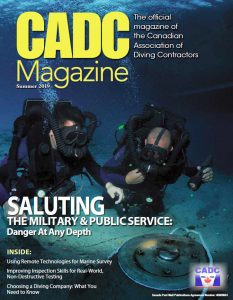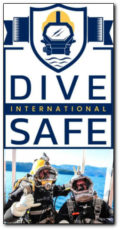CADC MAG SPRING/SUMMER EDITION AVAILABLE NOW FOR DOWNLOAD.
By CADC Admin ~ July 3rd, 2019. Filed under: CADC MAG, Latest Diving News, Safety.
 As we go to press with this Summer 2019 edition of CADC Magazine, the CSA Diving Standards Committee Z275 will be working on the finalization of items and changes on the Diving Operations Standard Z275.2-15. One of the biggest discussion points will be the determination and debate over a minimum dive crew on ALL occupational diving operations.
As we go to press with this Summer 2019 edition of CADC Magazine, the CSA Diving Standards Committee Z275 will be working on the finalization of items and changes on the Diving Operations Standard Z275.2-15. One of the biggest discussion points will be the determination and debate over a minimum dive crew on ALL occupational diving operations.
Very contentious, the decision will be effective in the dive standard starting January 2020, after public review over the summer and final ratification / approvals in November. By amendment, the current Z275.2-15 Standard requires a minimum competent crew of four individuals: supervisor, diver, standby diver, and tender on all surface supplied diving. Will it happen to SCUBA operations? The next issue will highlight the outcome of that decision, and the Canadian Association of Diving Contractors’ website, www.cadc.ca, will update in real-time as it evolves.
This issue, the focus is on a very select group within our CADC membership: the military and public service divers, specifically the Canadian Forces’ military diver units, the Ontario Provincial Police’s search and recovery unit, and the Canadian Coast Guard’s dive teams.
The commercial diving lifestyle may not be your thing. What if you wanted to earn money from your passion of diving but didn’t want to get into the cold realities of hardcore commercial diving in the mud and cold? What if you wanted to serve the public good? You can make your mark by joining the public service diving industry. But—how does one go from having this idea to becoming a CCG search and rescue diver, Canadian Forces clearance diver, OPP search and recovery diver, or public service diver? What qualifications or training do you need? What will be expected of you once you land a job? Well, we’re going to tell you how to go about it in our article on military and public service diving on page 16.
Having worked internationally with the NATO naval special forces groups for over 20 years as a documentary photographer in some of the toughest conditions imaginable, I have observed intense dedication of these men and woman to their trade—their effort is nothing but extraordinary. I also observed there is a common denominator—or trait—in them all. In my article on mine countermeasure diving, I experienced a tough split-second moral decision I had to make during a dive emergency on whether to photograph what appeared to be the impending death of one of our own—or to help. In the chaos of that milli-second, there was something else I noticed, too. Flip to page 19 to find out what it was.
Sometimes, getting into the water can be impractical and dangerous. High currents are one of the many dangers. Are there other ways to accomplish an inspection or complete work? Remote monitoring delivers significant bottom-line business benefits, enables service-business innovation, and delivers top-line growth. The feature by Bob Clarke, ASI Group, on page 23 will give readers some insight into how remote monitoring is done and what types of sensing equipment can be used. What they’ve done is quite unique.
Divers Institute of Technology recently revamped its non-destructive testing and inland projects to give students better practice on real-world diving inspection scenarios. The article by Michelle Perrigo on page 25 will dive right into it, exploring what makes this course unique, from doing video inspections on a pier, to visually inspecting the bottom of a boat in the water, to removing obstructions from a boat’s propeller or changing the buoyancy of a dock. Students learn about safety in different conditions, how tides affect different locations, and how to plan ahead and dive successfully in water that is ebbing or flooding.
On page 27, Hiring the Professional Diving Contractor reminds all that employing an underwater contractor ignorant of current safety standards and regulations can expose the employer to serious (and expensive) civil and criminal liability in case of an accident. Bill C-45 of the Criminal Code of Canada states it is the legal duty of employers and those directing work to take reasonable measures to protect employee and public safety. If this duty is disregarded and bodily harm or death results, a company could be charged with criminal negligence. Find out if it’s worth the risk (read: it’s not!), in this article.
CADC members have been busy over the year. The Our Members at Work photo spread on page 31 showcases images of an industry, from various members’ diving jobs across Canada.
STOP THE PRESSES:
CSA dive standards to require minimum four-person crew on all dive operations, including SCUBA
With the CSA Diving Committees Z275 series just held in May 2019, there were significant changes to the Diving Operations Standard Z275.2 that will come into effect January 1, 2020.
At the CSA Dive Standards meeting in May, the committee passed the requirement to have, as a default, a four-person minimal crew in all diving operations, including SCUBA.
There are (as there always were) certain conditions where SCUBA could be used with a three-person (competent) crew, should these conditions be met, and a job hazard analysis determines that a three-person crew could safely be used.
A working group is now working on those exceptions and formulating a Job Hazard Matrix, which will determine if a three-person crew can be used. A 60-day public review of the proposed changes will take place this summer for final approvals in the new Z275.2-20 Diving Operations standards to be published at the end of the year. We’ll have more information for our readers in the next issue of CADC Magazine.
Stay safe. Dive safe.







